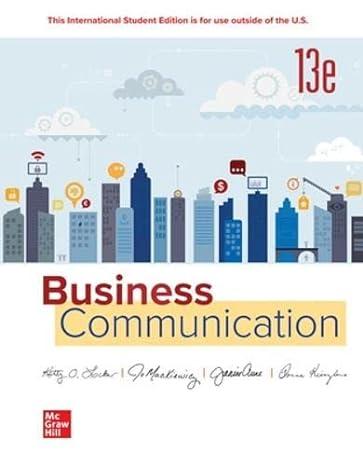TEDwhich stands for Technology, Education, and Designis an organization offering recordings of high-quality, authoritative, audience-adapted speeches on
Question:
TED—which stands for Technology, Education, and Design—is an organization offering recordings of high-quality, authoritative, audience-adapted speeches on a broad variety of topics. Speakers are invited to deliver speeches at a live event, and recorded speeches are showcased on the website. Visit http://ted.com to find a talk to analyze based on the following prompts.
■ Unless otherwise instructed, select an official TED talk rather than a TEDx talk; TEDx events are independently organized and do not undergo as strict a curation process.
■ TED talks can be sorted by topic, such as agriculture, aircraft, or animals, and by other descriptors such as
“trending.”
1. Select a TED talk in a category of interest and assess it based on the assessment questions below. Then, share your answers with your class in a brief oral presentation
(length determined by your instructor). Queue up relevant spots in the TED talk to illustrate your answers. As an alternate to an oral presentation, your instructor may ask you to compose a brief written analysis of the TED talk and email it to them.
2. Based on the talk you analyzed in part 1, prepare a brief presentation for your peers highlighting what they can learn from the presentation: Which techniques might they try to emulate in their own oral presentations? What best practices did the speaker exemplify? As an alternate to an oral presentation, your instructor may ask you to compose a “best practices”
list based on this TED talk and email it to them.
Assessment questions:
■ Assess the speaker’s content: Which of the three appeals—
credibility (ethos), emotional connection (pathos), or reasoning (logos)—was strongest, and why? Which element would have benefited from further practice or attention?
■ Assess the speaker’s nonverbal delivery: Which nonverbal delivery element (eye contact, facial expression, gestures, proxemics, or vocals) was strongest, and why? Which element would have benefited from further practice or attention?
■ Assess the speaker’s organization: How did the speaker preview the content? Review the content? How did the speaker signal movement from one idea to the next? What pattern of organization best describes how the content was arranged?
■ What did the speaker do to adapt their topic to this audience’s needs?
■ How well did the visual aid (if used), and its incorporation, meet the audience’s needs?
■ Why do you think this speaker was selected to deliver a TED talk at the live event?
■ Why do you think this recorded live speech was selected for inclusion on the website?
3. Select two TED talks in a category your instructor assigns and assess each based on the assessment questions above as well as the following additional assessment questions. Then, share your answers with your class in a brief oral presentation (length determined by your instructor). Queue up relevant spots in the TED talk to illustrate your answers.
Additional assessment questions:
■ Compare and contrast the speakers’ content: Which speech was more effective at creating content balanced in ethos, pathos, and logos?
■ Compare and contrast the speakers’ nonverbal delivery:
Which speaker was more effective at heightening interest, highlighting content, and connecting with the audience via nonverbal delivery?
■ Compare and contrast the speakers’ audience adaptation:
Which speech was more effective at anticipating and addressing the audience’s needs?
■ Compare and contrast the speakers’ use of visual aid(s):
Which speech was more effective at designing and integrating a visual aid to enhance spoken content?
■ If you had to select one speech to represent this category on the website, which would you select?
Step by Step Answer:

Business Communication
ISBN: 9781265045630
13th Edition
Authors: Kitty O. Locker, Jo Mackiewicz, Jeanine Elise Aune, Donna S. Kienzler Professor





